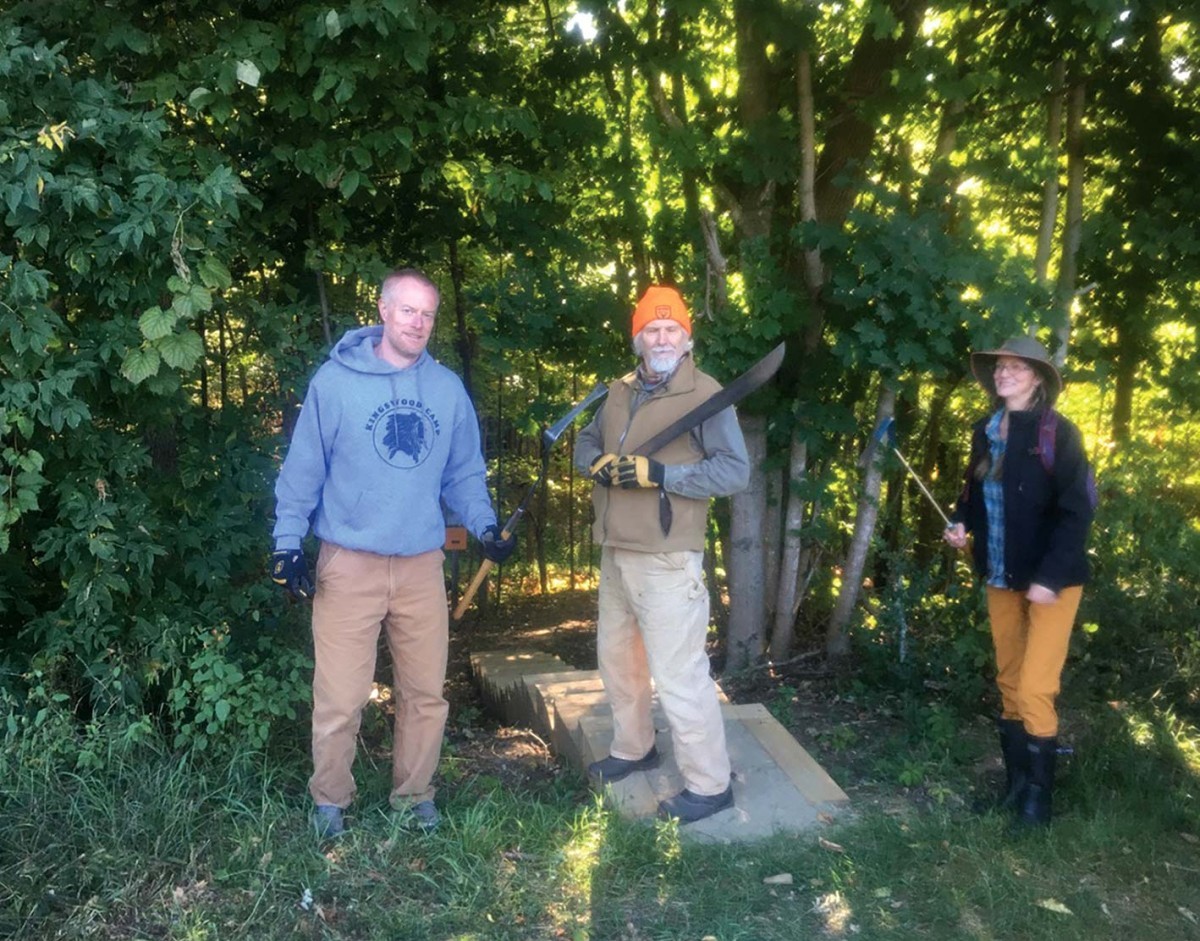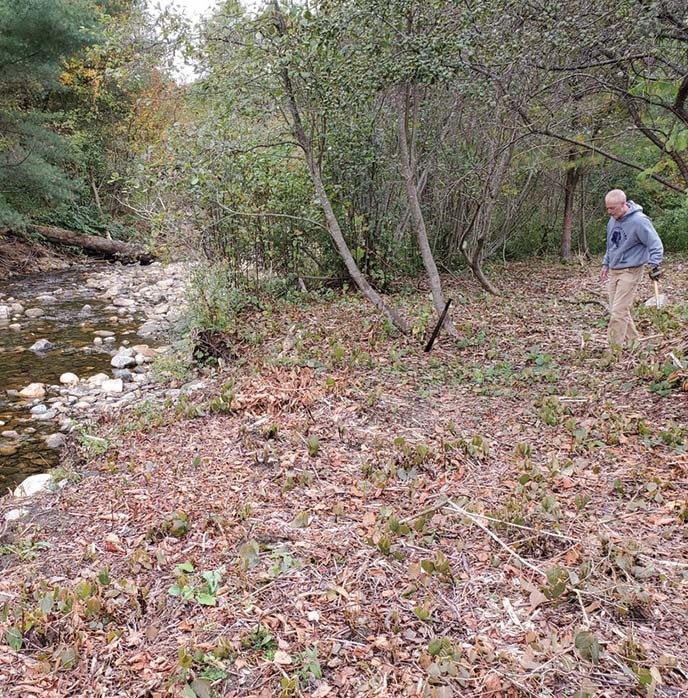
On a hot July morning on Market Street in Lyme, New Hampshire, Jaxon Morgan leaned against his car bumper swinging a long, black machete through the air. A quiet man with broad gestures, thick white hair beneath a baseball cap, and a natural cool, Morgan has been fighting invasive plants in the Upper Valley region for years. His latest opponent lies down a pine-padded trail that cuts through Big Rock Preserve, a few conserved acres just south of the Lyme town common. It is a species of plant instantly recognizable in New England and widely feared: Japanese knotweed.
Morgan is a member of the Lyme Biodiversity Working Group (LBWG), an offshoot of the town’s conservation commission. The group’s goal is to promote indigenous species and proactive land management, including in the public forest at Big Rock. Eradicating knotweed is one of LBWG’s main goals.
Known across the United States for choking out brook banks and roadsides, knotweed spread from its native range in Japan through its sale as an ornamental plant in the late nineteenth century.
Its growth has been explosive, and it is one of the most prevalent and recognizable invasive species in many parts of the country. Listed as one of the most damaging invasive plants by the World Conservation Union, it is currently known to grow in 42 states in the United States. With rootstock that can vigorously re-sprout and choke out nearly any competitor, and a tolerance of a wide range of soil types, knotweed has proven to be a formidable invader.

The LBWG chose Big Rock as its focus because of its “saturation” of invasives. Morgan rattled off a laundry list to strike terror into the heart of a native plant lover or a conservation group: common buckthorn, multiflora rose, Japanese barberry, garlic mustard, Oriental bittersweet, and burning bush. Saturation indeed. But first on the group’s list was knotweed, whose eradication from the site they expected to be a 9- to 10-year endeavor.
The effort began in 2018, and community enthusiasm led to early progress. Across eight working days last summer, approximately 100 volunteers – from Lyme and beyond – cut their way through Big Rock’s knotweed stands. Local business groups pitched in on workdays, college classes filtered through, even a group from a nearby sleepaway camp helped. “Fifteen teenage boys with machetes,” Morgan said. “They kicked butt.”
But a handful of land stewards, funded through grant writing efforts of the LBWG, have done a large share of the core work at Big Rock, especially since the pandemic put an end to large community workdays. The stewards work to cut knotweed patches up to a dozen times a summer, revisiting the roots again and again in a quest to exhaust them, and piling plant matter on elevated pallets where the decomposing weed is monitored for new shoots. From taking a machete to robust, mature stands – Morgan sharpens his after every use – to finger plucking young stalks from the soil, the group does all the work manually.
Although herbicides as potent as glyphosate are sometimes used on knotweed, Big Rock stewards eschew chemicals out of a faith in physical work – as well as a concern for the ecosystem as a whole.
One land steward, Charity Haggett, expressed satisfaction not only in defeating knotweed but also in the subsequent resurgence of native plants. She has begun to catalogue and track their appearance: Joe Pye weed, American hog peanut, enchanter’s nightshade, aster, goldenrod, and an array of ferns. Expressions of gratitude from dog walkers and joggers slipping through the park is another source of reward.
“They want to know if I’m one of those knotweed people,” Haggett recounted. “Then they tell me how thankful they are for what we’re doing here.”
The community solidarity, the insistence on physical removal in place of aggressive herbicides, the promising return of native species, and the continuation of work despite the pandemic – there is much to admire in the little project spreading across the few acres along Grant Brook. Most astonishing is the sheer extent of the group’s success.
Walking down into Big Rock, the forest leads to a brook bank of shaded ferns. The sound of the water running over stones rises up. Where once a stand of knotweed 6, 7, 8 feet tall ran like a wall through the ecosystem, the forest is unbelievably, almost miraculously, opened. The absence of the plant is palpable; a sense of completeness has been restored.
After 12 cuttings during two summers, there was neither a knotweed leaf nor stalk in sight. But Morgan said the roots remain, hidden out of sight – but not out of mind for the LBWG members committed to the ongoing effort. The stewards will continue cutting for as long as it takes to exhaust the rootstock, and they often find new patches of the weed. Then there is the issue of tackling the other invasive plants.
But the progress that has been made in Lyme is at once astonishing and seemingly replicable: during the course of a few summers, the community and its stewards have done wonders to reopen the riverbanks of Grant Brook.


